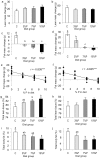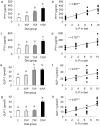Dose-dependent effects of a soluble dietary fibre (pectin) on food intake, adiposity, gut hypertrophy and gut satiety hormone secretion in rats
- PMID: 25602757
- PMCID: PMC4300082
- DOI: 10.1371/journal.pone.0115438
Dose-dependent effects of a soluble dietary fibre (pectin) on food intake, adiposity, gut hypertrophy and gut satiety hormone secretion in rats
Abstract
Soluble fermentable dietary fibre elicits gut adaptations, increases satiety and potentially offers a natural sustainable means of body weight regulation. Here we aimed to quantify physiological responses to graded intakes of a specific dietary fibre (pectin) in an animal model. Four isocaloric semi-purified diets containing 0, 3.3%, 6.7% or 10% w/w apple pectin were offered ad libitum for 8 or 28 days to young adult male rats (n = 8/group). Measurements were made of voluntary food intake, body weight, initial and final body composition by magnetic resonance imaging, final gut regional weights and histology, and final plasma satiety hormone concentrations. In both 8- and 28-day cohorts, dietary pectin inclusion rate was negatively correlated with food intake, body weight gain and the change in body fat mass, with no effect on lean mass gain. In both cohorts, pectin had no effect on stomach weight but pectin inclusion rate was positively correlated with weights and lengths of small intestine and caecum, jejunum villus height and crypt depth, ileum crypt depth, and plasma total glucagon-like peptide-1 (GLP-1) and peptide tyrosine tyrosine (PYY) concentrations, and at 8 days was correlated with weight and length of colon and with caecal mucosal depth. Therefore, the gut's morphological and endocrine adaptations were dose-dependent, occurred within 8 days and were largely sustained for 28 days during continued dietary intervention. Increasing amounts of the soluble fermentable fibre pectin in the diet proportionately decreased food intake, body weight gain and body fat content, associated with proportionately increased satiety hormones GLP-1 and PYY and intestinal hypertrophy, supporting a role for soluble dietary fibre-induced satiety in healthy body weight regulation.
Conflict of interest statement
Figures




References
-
- Institute of Medicine, National Academy of Sciences (2005) Dietary reference intakes for energy, carbohydrate, fiber, fat, fatty acids, cholesterol, protein and amino acids. National Academies Press, Washington DC. - PubMed
Publication types
MeSH terms
Substances
LinkOut - more resources
Full Text Sources
Other Literature Sources
Medical

